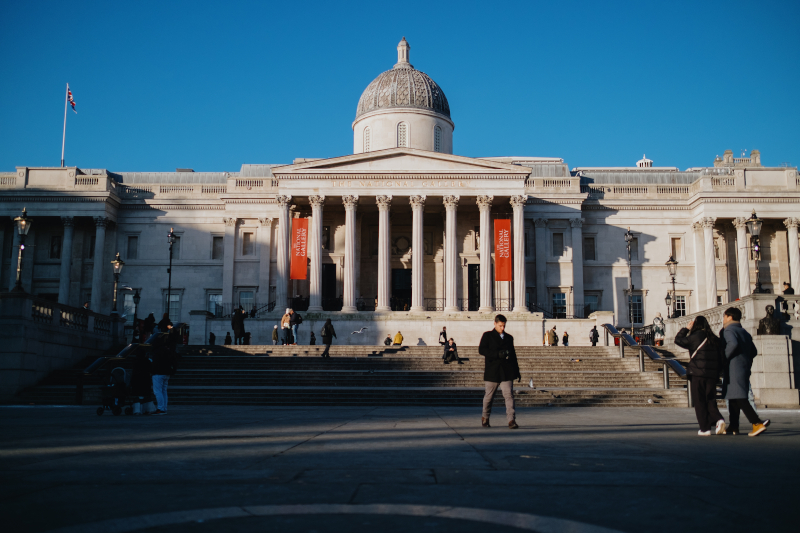Director – Phil Grabsky, Ali Ray – 2024 – UK – Cert. U – 98m
*****
Employees, punters and celebrities choose their favourite painting in London’s National Gallery – out in UK cinemas from Tuesday, June 4th
There have been documentary films about the UK’s National Gallery before, notably the wonderful, three-hour-long National Gallery (Frederick Wiseman, 2014), so, in a way, it’s a brave subject for the Exhibition on Screen people to take on. And yet, as a British production company making movies about art in art galleries, it was inevitable that they would tackle the subject sooner or later. Their version commences with a likeable enough establishing montage of what one might call ‘behind the scenes’ and ‘footfall’ – shots of various National Gallery employees at work opening the door, looking after various aspects of the art housed in the gallery and even putting out tasty-looking croissants in the cafeteria.
There are satisfying little touches throughout. A shot of The Feast Day of Saint Roch, Canaletto, with out of focus people passing in front of it, makes it feel like you’re really there in the scene depicted.
Alan Allison, security officer and gallery assistant (pictured on the front of the trailer, below) wears black clothing with a striking, patterned blue tie. He clearly loves being at the gallery, soaking up the art and reading about it whenever he can after hours. Yet, as a black person, he laments the lack of representation of people like himself – he talks of the “colonial bubble”, the slave trade. He feels that the institution could do a lot more to represent the diversity of people who have made positive contributions to British society as it is now.
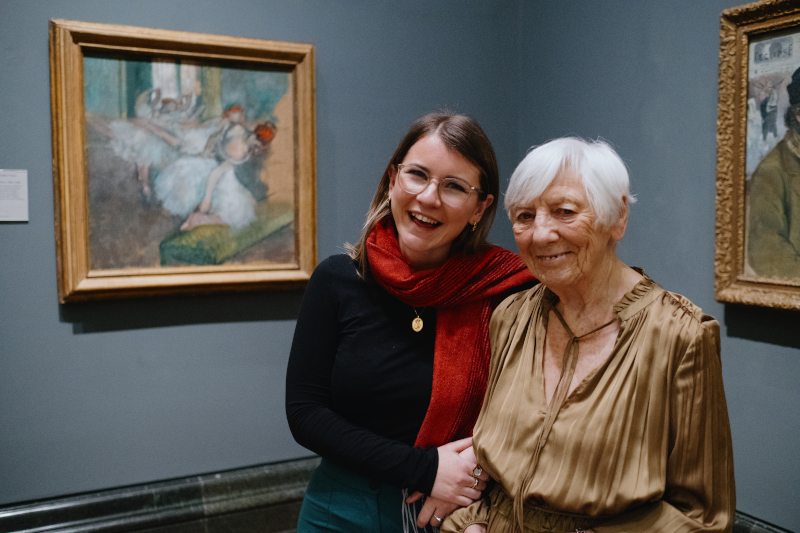
As a child, Helena Fitzgerald, corporate development manager, National Gallery, was often bought to the gallery by her nan. Her nan’s favourite. Ballet Dancers, Edgar Degas, 1890-1900. Helena herself went to ballet school, so this picture shows what she thought she was going to be. Ann Fitzgerald, her grandmother, 87, also puts in an appearance (sitting beside Helena on one of the Gallery’s benches overlooking the painting). She talks about how the Gallery is more open and welcoming than it used to be, with more varied visitors including more young people than back in the day.
These two interviewees give an idea of what is to come – a series of interviews in which people talk firstly about the National Gallery and secondly a specific painting they admire. Mostly they are fascinating, providing unexpected insights into both the pictures and their own lives. Some work for the Gallery in one capacity or another, some are members of the public who frequent the place.
Jonathan Conlin, historian & author, The Nation’s Mantelpiece, is the one exception to all this. His book is a history of the National Gallery, and he is, if you will, the film’s a resident expert, guiding us through a history of the institution. The Gallery was set up by Sir George Beaumont, a member of the aristocracy who in addition was not only a collector but also a painter himself, in the early nineteenth century. For its first 14 years, the collection was housed in serial buildings in Pall Mall, in what Conlin describes as a constricted hang.
Following some amazing, colourized, pre-WW2 footage of the National Gallery in Trafalgar Square with buses travelling to and fro, come black and white stills of bombed out buildings from the Blitz. Conlin again: While most artworks in British galleries were evacuated to safe storage places – in the National Gallery’s case, to a slate mine in Wales – then Gallery director Kenneth Clark embraced a suggestion in a letter to The Times that paintings be put on in a one-painting show for one month in the otherwise empty Gallery. Every time there was an air raid warning, the painting would be taken off the wall and moved downstairs to a place of safety. The other great event on the Gallery’s premises in wartime were classical piano concerts performed by Dame Myra Hess, forever captured in the short Listen to Britain (Humphrey Jennings, Stewart McAllister, 1942).
King George V’s architect John Nash was responsible for the remarkable current site of the National Gallery, says Conlin. He talks about current development plans for the Crown Estates land to the West and North of the present-day Trafalgar Square. The current building was opened in 1838 and originally housed, in addition to the National Gallery, such other institutions as the Public Record Office and the Royal Academy. In the open space before the Gallery, Nelson’s Column was created in the mid-1840s. Today, the square affords views of the Houses of Parliament and Canada House, and borders on the Strand, the street which links Westminster to the City of London. Accompanying a striking aerial composition of Trafalgar Square and the Gallery above it, he describes the location as the place from which the centre of London is measured. (Personally, I’ve always thought of Oxford Circus in that regard – but there you go.)
One of several celebrities to appear, Michael Palin, introducing himself as a traveller, actor and general hack, picks Turner’s Rain, Steam, Speed, the familiar image of a train crossing a viaduct. For Palin, it’s Turner’s science fiction painting, it’s the future, juxtaposing against the beauty of the countryside this man-made machine. A new world with enormous possibilities, to which people are going to have to adapt. Palin finds numerous details in the painting which I personally have never previously spotted – figures on the riverbank below the viaduct, a skiff on the river, and a tiny hare running ahead of the locomotive, the old world, as it were, racing against the new.
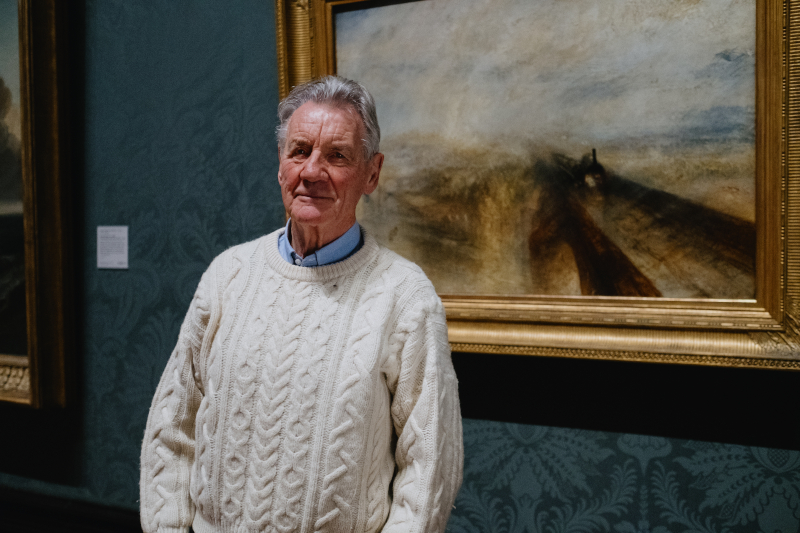
Kasper Pincis is an art handling supervisor. “Essentially,” he explains, “ the art handling department is the arms of the Gallery -we’re in charge of all the moving and the installation of the collection. One of his favourites is Birds, Butterflies and a Frog among Plants and Fungi, Melchior d’Hondecoeter, 1668. He describes it as slightly dark, yet gleaming like a jewel. Birds aggravated by a frog, a microcosm of drama in a small space. There’s nothing else exactly like this in the collection. It was recently on display for a year, and he expects it will be up on a public wall again before too long. It’s nice, he comments, to see a painting like this have its moment in the sun.
Tracey Jones, Head of Communications, chose Witches at their Incantations, Salvador Rosa, c. 1646. Tucked away in a slightly dark corner of room 32, which makes it sound occult (the word literally means hidden). “Strange, scary, spooky and weird,” she says, “ and I absolutely love that. People hanging, people resurrecting corpses, strange monsters, people cutting toenails of people hanging in trees – I can’t work out what’s going on, and that’s why I absolutely adore it.” She talks of getting up close to examine the detail, the variations of darkness, the night time on an Italian hillside. She talks about reading the narrative of the picture from left to right. The fabulous mythical creatures came out of the melting pot of Salvatore Rosa’s mind and what was going on in Florence at that time. She points out that in the mid-seventeenth century, when the picture was made, people were still being tried and executed for witchcraft. It turns out that Jones is also on the programming team that helps select short films for the independent Horror-on-Sea Film Festival which takes place annually in January. “This painting speaks to me,” she says, “because you’ve got all the tropes of a great horror movie in this one static image.”
People being brought to the Gallery as children (particularly girls by their mothers or grandparents) is a recurring theme. Saffron Bowdler, Marketing Executive, Nat Gall. Bacchus and Ariadne, Titian, 1520-23. When she used to visit the Gallery with her father, separated from her mother, she was struck with this particular painting and also the fact that her father, who was himself a painter, would ask her questions about art. She talks about, as she has grown up with the painting, she has at various times looked at it through different lenses – as an artefact associated with her father when she was small, from the point of view of feminism when she was a young woman studying art history at university, and as an exploration of the complexities of human life now that she’s much older. She talks about the multiple layers of the painting, relating elements of it to her own personal family history, For her, the painting is about what it is to be human – we are complex creatures, we are not perfect. Artists bring a unique perspective of human existence.
For Stacey Smith, membership & commercial services assistant, it’s The Ambassadors, Hans Holbein the Younger, 1533, which is not quite what it appears to be, For a start, there’s the indecipherable blob in the bottom centre which, if you look at it from the side, is revealed to be a human skull. Overall, the painting was a diplomatic tool for the French ambassador (pictured) to get a message to the King of France about what was actually going on in England at the time, and is filled with such cryptic clues as, the lute with a broken string and a piece of music containing numerous incidents of the note of the broken string which therefore cannot be played. In a theme which recurs over and over in this documentary, it’s also a picture she pondered over with her late grandad. If she stands and looks at the painting, for her, it’s like he never passed away.
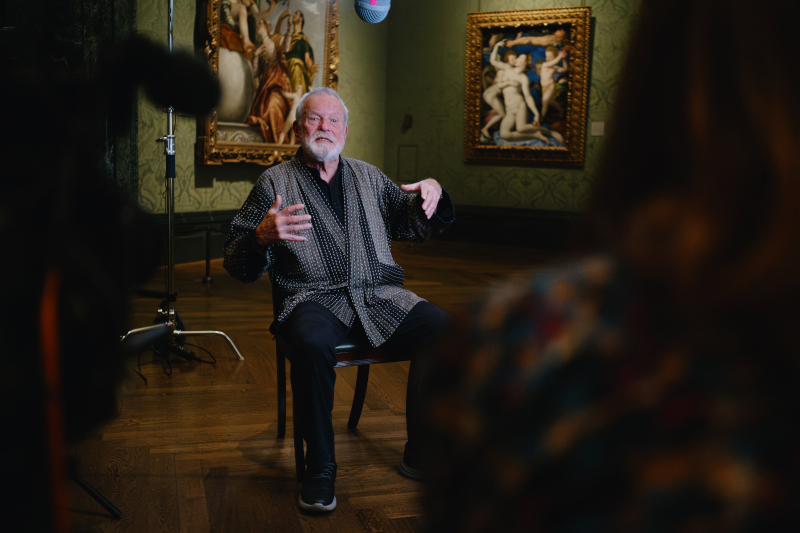
A slightly dodgy-looking, elderly man (I hope Terry Gilliam won’t mind me calling him that – I mean it with the utmost respect, honest!) moves back and forward studying detail’s in Venus, Cupid, Folly and Time, Bronzino, 1545. It’s one of the few paintings here to be known under different titles – Gilliam refers to it as Allegory of Venus, Cupid and Folly, the documentary’s own titles call it An Allegory of Venus and Cupid. He relates how in the early days of TV comedy series Monty Python’s Flying Circus, on which he was the animator, he would visit the Gallery in search of properties to steal – of which he would buy postcards, posters or books, then photograph and manipulate the images on camera. In the bottom LH corner of the Bronzino is a foot about, at least in Gilliam’s eyes, to crush a dove. He appropriated what quickly became “the Python foot” as a tool of punctuation to rapidly bring to a close whatever was going on on the screen. He then embarks on a fascinating reading the painting as a warning to the viewer about the dangers of Syphilis, pointing out that the adjective venereal (as in venereal disease) comes from Venus, and expresses regret that his animations don’t come anywhere near the level of artistry of this painting.
The nature of the film, which one might describe as a series of vignettes, means that if exhibition of screen ever wanted to turn one of their film’s into an interactive Blu-ray or DVD or website, where you could click on a painting and hear someone who loves it talk about it either briefly or at great length, the footage in this film (and perhaps additional material that didn’t make the final cut, should there be any) would be the perfect place to start.
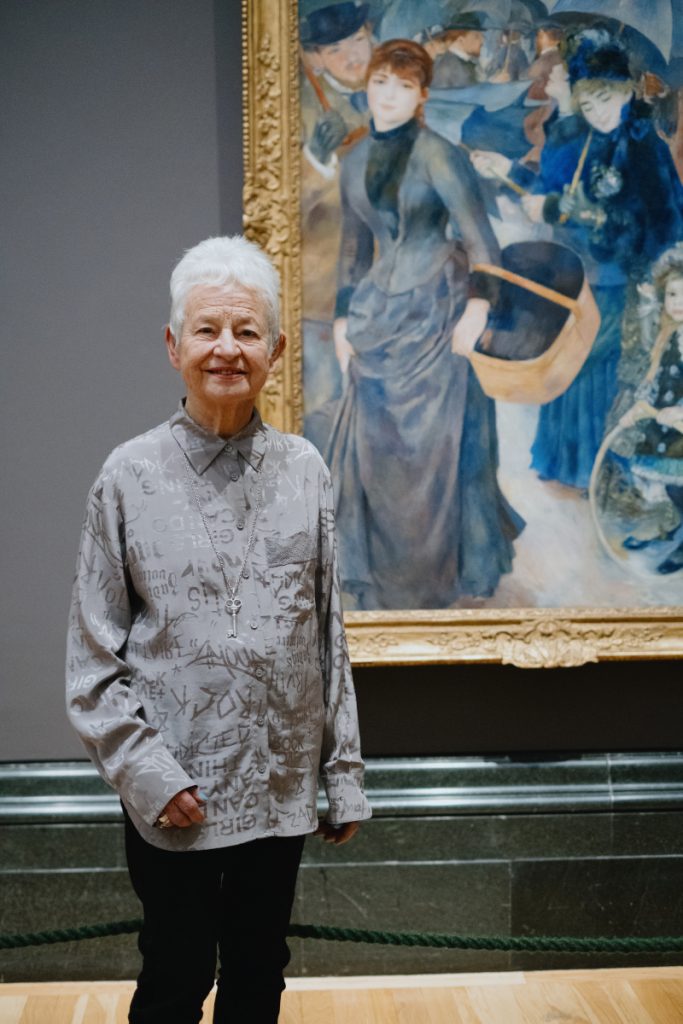
Acclaimed children’s author Jacqueline Wilson loves the Gallery. She was first taken there by her dad as a small girl on a day trip, where her dad, a draughtsman, introduced her to Canaletto’s paintings. A huge admirer of the Impressionists, she chooses The Umbrellas, Pierre-August Renoir, c. 1881-1886, painted at a time when women were discovering there were more things to do. This joyful painting seemed to be telling her a story with a young woman who has an expression that suggests she has a secret that suggests you, the viewer, is going to be let in on it. She likes a strong narrative in a painting – “and, if there isn’t one, I make it up”. She talks about the working class girl here as an inspiration for her own character Hetty Feather.
Regular Gallery visitor Peter Murphy, a former TV producer who had a drug problem, currently a piano teacher, finds the most significance in Madonna of the Meadow, Giovanni Bellini, c. 1500-1505. He describes leaving his first Narcotics Anonymous meeting in a state of emotional turmoil, going into the Gallery and coming across this painting, standing in front of it and being struck by the way the woman towers over everything in the painting, like a pyramid. He knew there was a meaning to the painting, and the more he looked, the more it gave up its secrets. He talks about the fact that his mother couldn’t mother, that he was raised by other family members and never felt loved,and that in this painting he saw a vital connection of a mother’s love for a child. He cried standing in front of it. He praises the fact of the National Gallery being free, without which he wouldn’t have discovered this particular picture and gone on the journey he did with it. “It’s my club,” he says, “it’s my National Gallery. I feel like I belong here. I feel like I’ve come home.”
The film has the wit to use the Gallery’s closing announcement at the end of the day over its end credits.
Exhibition on Screen: My National Gallery is out in cinemas in the UK from Tuesday, June 4th. Check your local cinema for details or click here.
Trailer:
